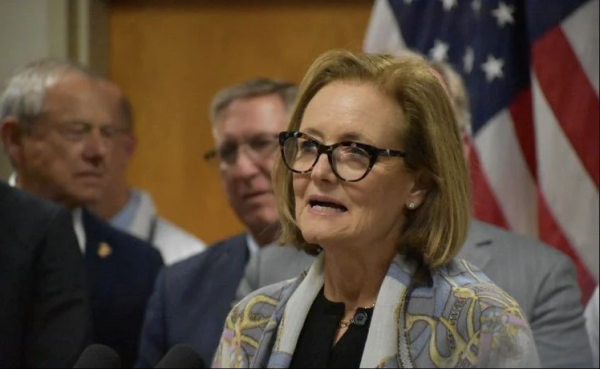April 8, 2025

Kate Walsh, secretary of the Executive Office of Health and Human Services, spoke during a press conference at Saint Anne's Hospital in Fall River on Tuesday, Nov. 19, 2024. SHNS photo
The splintering of Steward Health Care last year resulted in the transfer of six hospital campuses, the closure of two others, and a reshaping of the state's health care world. That might be just the start of a rethinking of the role hospitals can play in Massachusetts, Health and Human Services Secretary Kate Walsh said Monday.
Walsh spent most of 2024 engrossed in Steward's bankruptcy, a saga that concluded Oct. 1 when hospitals in Boston, Brockton, Fall River, Haverhill, Methuen and Taunton were handed over to new owners. Steward shuttered Carney Hospital in Dorchester and Nashoba Valley Medical Center in Ayer about a month earlier. Walsh and Gov. Maura Healey arranged for a state aid package totaling at least $417 million over three years to help the new operators, and the state convened local task forces to address health care desserts in the areas Steward fled.
The secretary's musing on the future of hospitals came in response to a question from a member of the Nashoba Valley working group, Rep. Margaret Scarsdale of Pepperell, at a budget hearing Monday in Attleboro.
"I think we all have to think differently about what hospitals are and what they'll be in the future. Hospitals are such iconic parts of communities; people are born there, they die there, they get better there, it creates a lot of jobs, it's a center, it supports the deli guy across the street because people forget to bring their lunch," Walsh said. "I grew up working in hospitals. I love hospitals. I hate to see them close. The sad fact is, across our country, there are 1,300 critical access hospitals -- there's one in Massachusetts, in Athol -- and a third of those hospitals were projected to close. The small community hospital is, it's just really threatened. It's threatened by changes in how people live their lives, it's threatened by changes in how health care is delivered."
Walsh was senior vice president of Massachusetts General Hospital from 1988 until 2002, executive vice president and chief operating officer of Brigham and Women's Hospital from 2004 until 2010, and spent 13 years as president and CEO of Boston Medical Center Health System before joining the Healey administration.
Last Wednesday, the Center for Health Information Analysis (CHIA) released its hospitals financial report for the quarter that ended Dec. 31, 2024 -- the first complete reporting period in which Steward was no longer an operator of Massachusetts hospitals.
The data show the statewide median operating margin for hospitals was -0.7% and that 55% of Massachusetts hospitals reported negative operating margins during the final three months of 2024. Sixteen of the 21 reporting health systems (hospitals and affiliated physician practices) told CHIA they experienced negative operating margins during that timeframe.
"CHIA's quarterly reports are no longer a warning sign; they are a red alert for the painful financial conditions our local hospitals are enduring. After half a decade of economic turmoil for Massachusetts healthcare providers, the consequences have become more dire and visible than ever — whether they be layoffs, packed EDs, or reduced investments in new technologies and facilities," Daniel McHale, senior vice president of healthcare finance and policy at the Mass. Health and Hospital Association, said.
Walsh told lawmakers Monday that "what I think we need to do here in Massachusetts is a little bit of what's happened as a result of the closures at Carney and Nashoba."
"I think at Carney we'll see a combination of health care delivery, a school and housing. That's great for that neighborhood. I think that we just have to think differently about what success looks like and I say that acknowledging that it's very hard for communities to give up their hospitals," she said. "But this is not the last conversation like this we'll have in the next couple of years."
The secretary said the primary goal would be to make sure that people have access to the services they need in the most effective way they can be delivered. She said "everybody thinks, 'Oh, I have cancer, I have to go to the hospital'," but most cancer care today is done in outpatient infusion centers. She also mentioned ambulatory surgery, imaging and screening as the kinds of in-demand services that can be delivered without a hospital in the traditional sense.
UMass Memorial Health, the largest nonprofit health care system in Central Massachusetts, announced in January that it plans to establish a new standalone emergency department in the Nashoba Valley region and also offer "certain imaging services." Walsh on Monday told Scarsdale that her district will have "a satellite emergency facility so that people won't be in the back of ambulances, you know, very worried that they're taking their last breath."
"I think that we have the beginnings in the Nashoba Valley of a more durable and sustainable health care delivery system," Walsh said.
The secretary said she is hopeful for the Nashoba Valley region because "what we had was an empty community hospital that people just weren't using."
"Because if somebody was using it, it would have been more economically viable [to buyers]. I mean, person after person went through that facility, buyer after buyer went through that facility, and said, 'We just can't make it work.'," she said.


